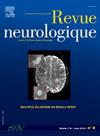Prevalence and management of psychosis in an outpatient population with Parkinson's disease: A real-life descriptive study
IF 2.3
4区 医学
Q2 CLINICAL NEUROLOGY
引用次数: 0
Abstract
Background
Previous studies reporting prevalence of psychosis were predominantly cross-sectional, with a limited focus on the full spectrum of features seen in psychosis associated with Parkinson's disease (PDPsy).
Objectives
To assess the prevalence of PDPsy, explore the association of PDPsy with demographic, drug-related, and disease-related characteristics and describe the management of PDPsy in an outpatient population with PD.
Methods
We analysed the psychosis prevalence and clinical correlates in PD patients seen for an outpatient visit at the Parkinson Expert Centre of Rouen. PD patients were evaluated with detailed clinical history taken by an investigator trained in PD (DM). Psychosis was diagnosed according to NINDS diagnostic criteria. PDPsy characteristics were collected using a standardized questionnaire composed of ten qualitative items on hallucinations, minor phenomena, and delusions. All PD patients considered to have a previous or ongoing PDPsy underwent an interview to assess the age at onset, exacerbating and relieving factors, the management and outcomes.
Results
From June to December 2021, 315 outpatients with PD were included in the study, 42% had previous or ongoing psychosis, mostly visual hallucinations. PD patients with PDPsy were older, with a more advanced form of the disease and were treated with a higher dose of anti-Parkinson drugs. Psychotic symptoms can be adequately managed with nonpharmacoligical approaches, while in other patients, reduction or withdrawal of drugs, or introduction of clozapine was necessary.
Conclusions
Untreated PDPsy is associated with impaired quality of life, and significant distress to caregivers and patients. Early detection of psychotic symptoms may yield prognostic and therapeutic benefits.
帕金森病患者门诊人群精神病的患病率和管理:一项真实的描述性研究。
背景:先前报道精神病患病率的研究主要是横断面的,对帕金森病(PDPsy)相关精神病的全谱特征关注有限。目的:评估PDPsy的患病率,探讨PDPsy与人口学、药物相关和疾病相关特征的关系,并描述门诊PD患者PDPsy的处理。方法:我们分析了鲁昂帕金森专家中心门诊PD患者的精神病患病率和临床相关因素。PD患者由经过PD (DM)培训的研究者根据详细的临床病史进行评估。根据NINDS诊断标准诊断精神病。采用标准化问卷收集PDPsy的特征,问卷由十个关于幻觉、轻微现象和妄想的定性项目组成。所有被认为有既往或正在进行的PD患者都接受了访谈,以评估发病年龄、加重和缓解因素、管理和结果。结果:2021年6月至12月,315例门诊PD患者纳入研究,42%既往或持续患有精神病,以视幻觉为主。患有PDPsy的PD患者年龄更大,病情更严重,接受更高剂量的抗帕金森药物治疗。精神病症状可以通过非药物方法得到充分控制,而在其他患者中,减少或停药或引入氯氮平是必要的。结论:未经治疗的PDPsy与生活质量受损有关,并对护理者和患者造成重大困扰。早期发现精神病症状可能带来预后和治疗益处。
本文章由计算机程序翻译,如有差异,请以英文原文为准。
求助全文
约1分钟内获得全文
求助全文
来源期刊

Revue neurologique
医学-临床神经学
CiteScore
4.80
自引率
0.00%
发文量
598
审稿时长
55 days
期刊介绍:
The first issue of the Revue Neurologique, featuring an original article by Jean-Martin Charcot, was published on February 28th, 1893. Six years later, the French Society of Neurology (SFN) adopted this journal as its official publication in the year of its foundation, 1899.
The Revue Neurologique was published throughout the 20th century without interruption and is indexed in all international databases (including Current Contents, Pubmed, Scopus). Ten annual issues provide original peer-reviewed clinical and research articles, and review articles giving up-to-date insights in all areas of neurology. The Revue Neurologique also publishes guidelines and recommendations.
The Revue Neurologique publishes original articles, brief reports, general reviews, editorials, and letters to the editor as well as correspondence concerning articles previously published in the journal in the correspondence column.
 求助内容:
求助内容: 应助结果提醒方式:
应助结果提醒方式:


